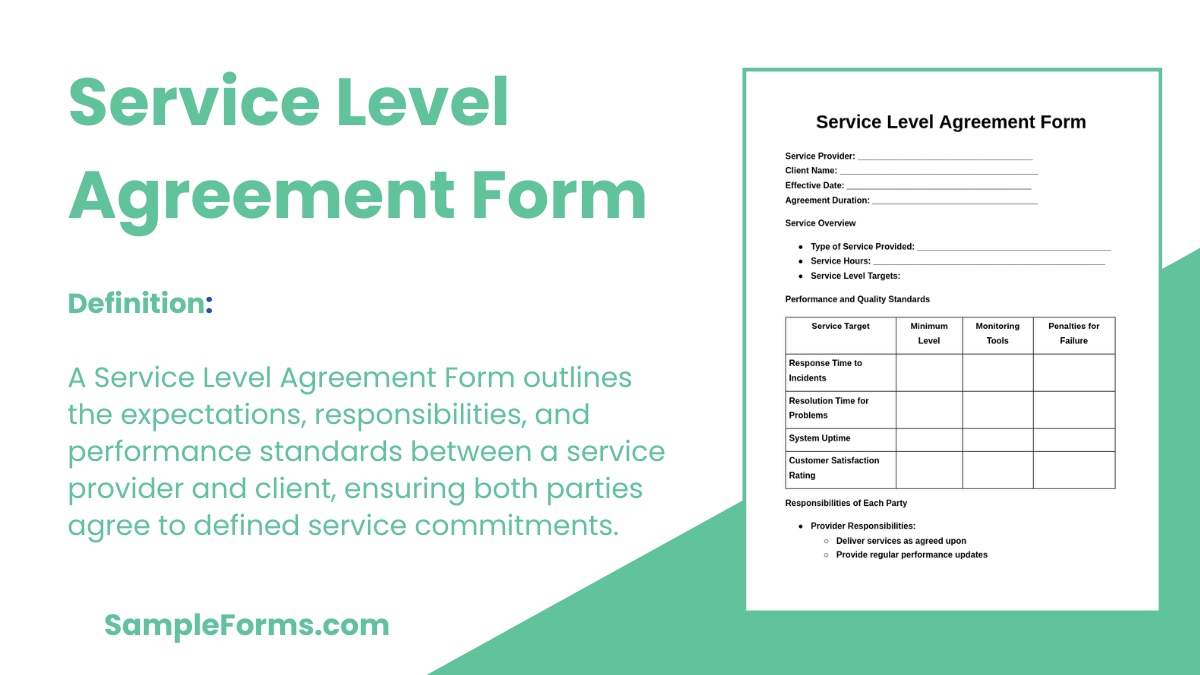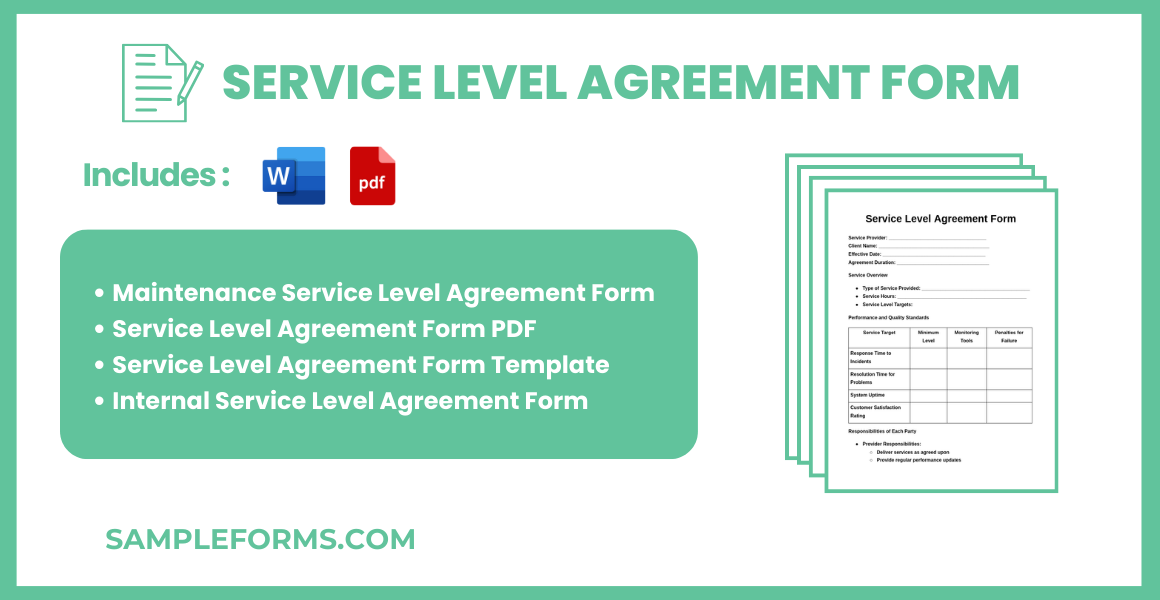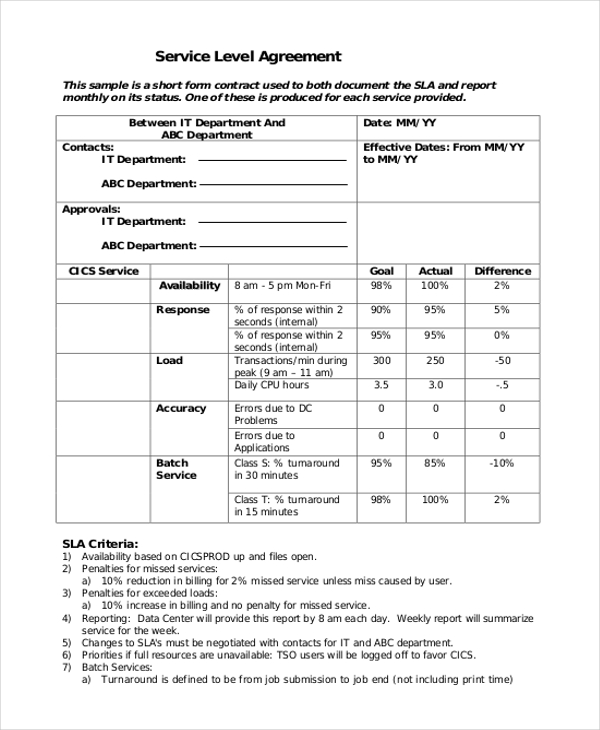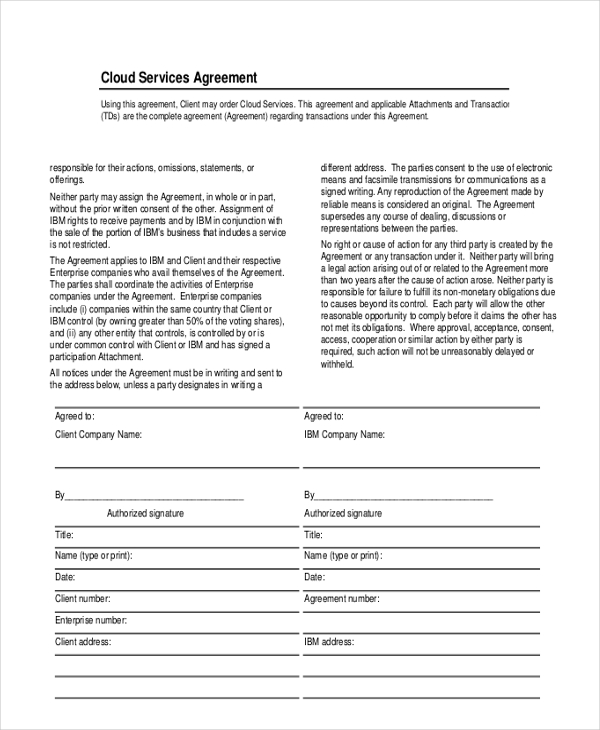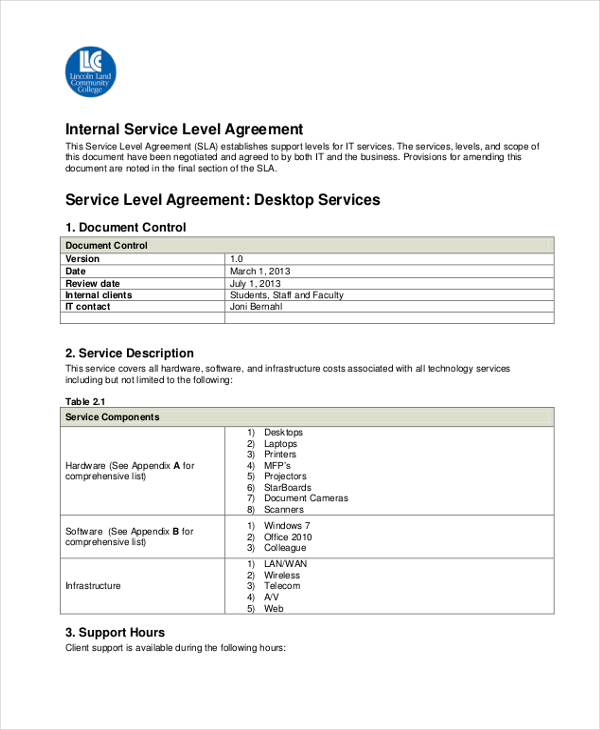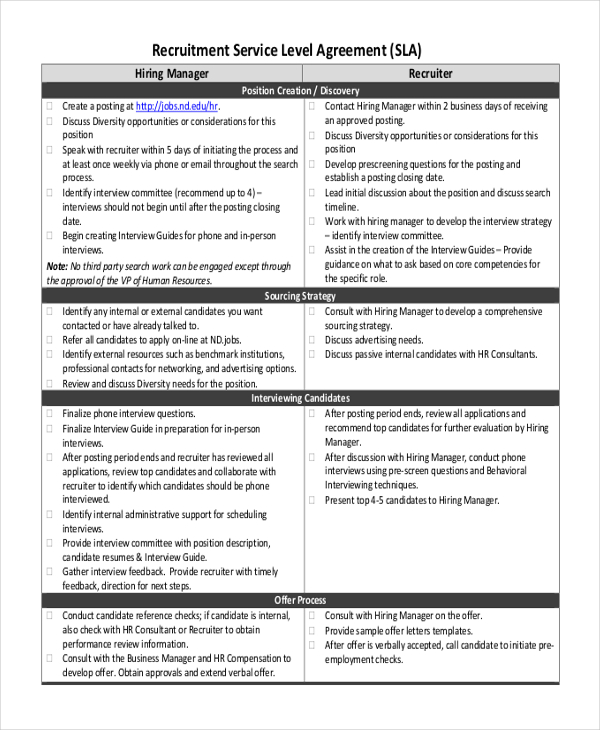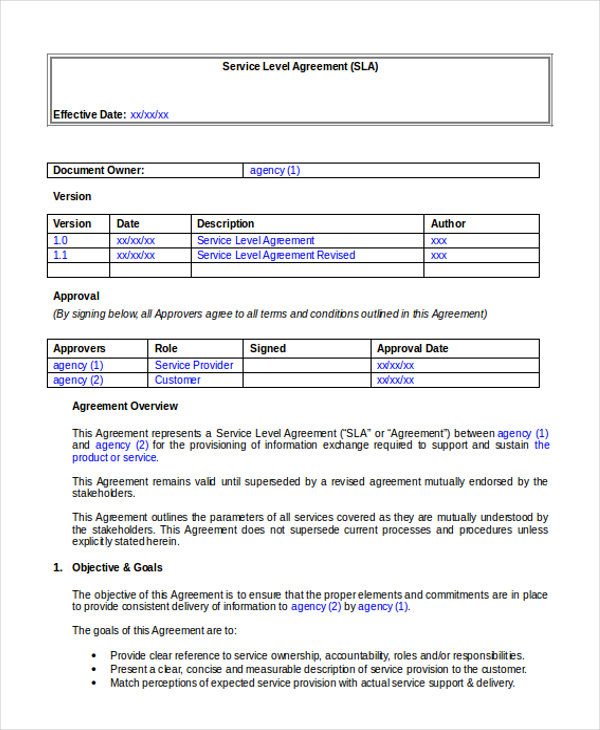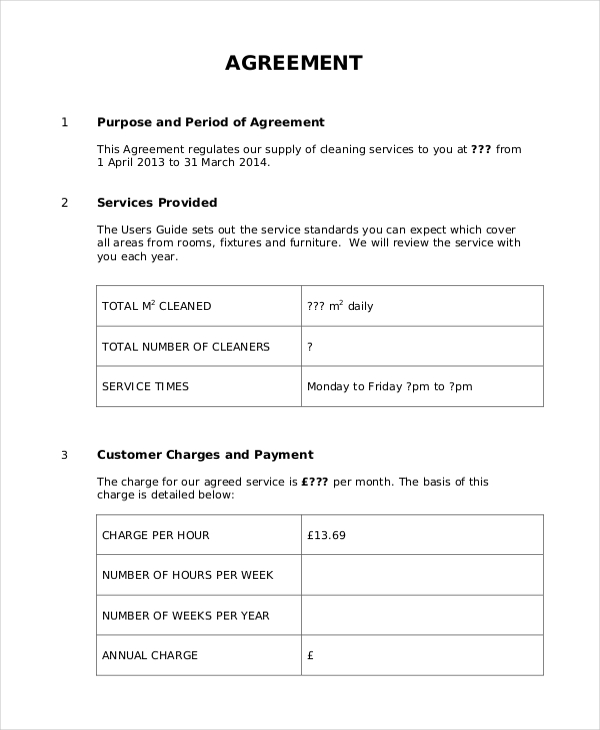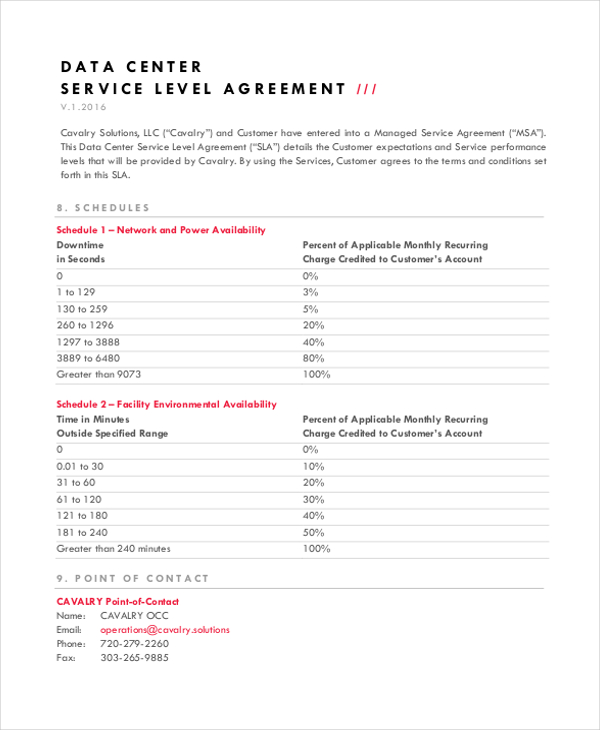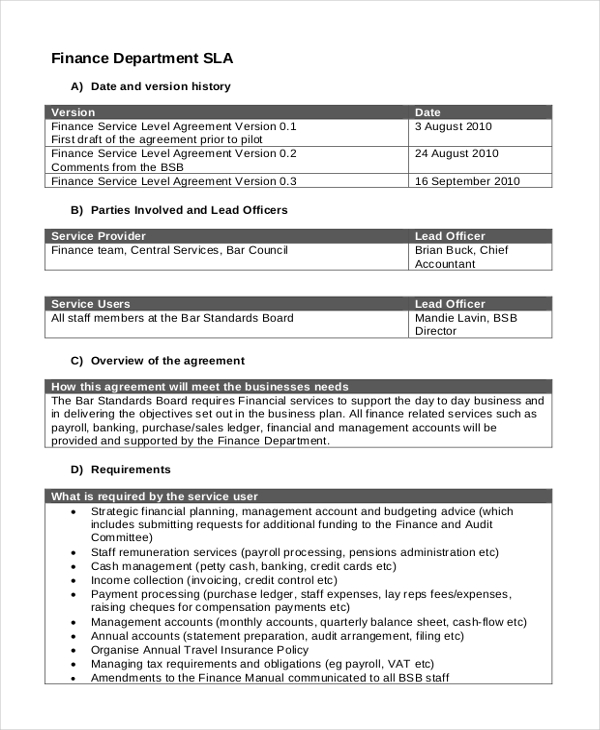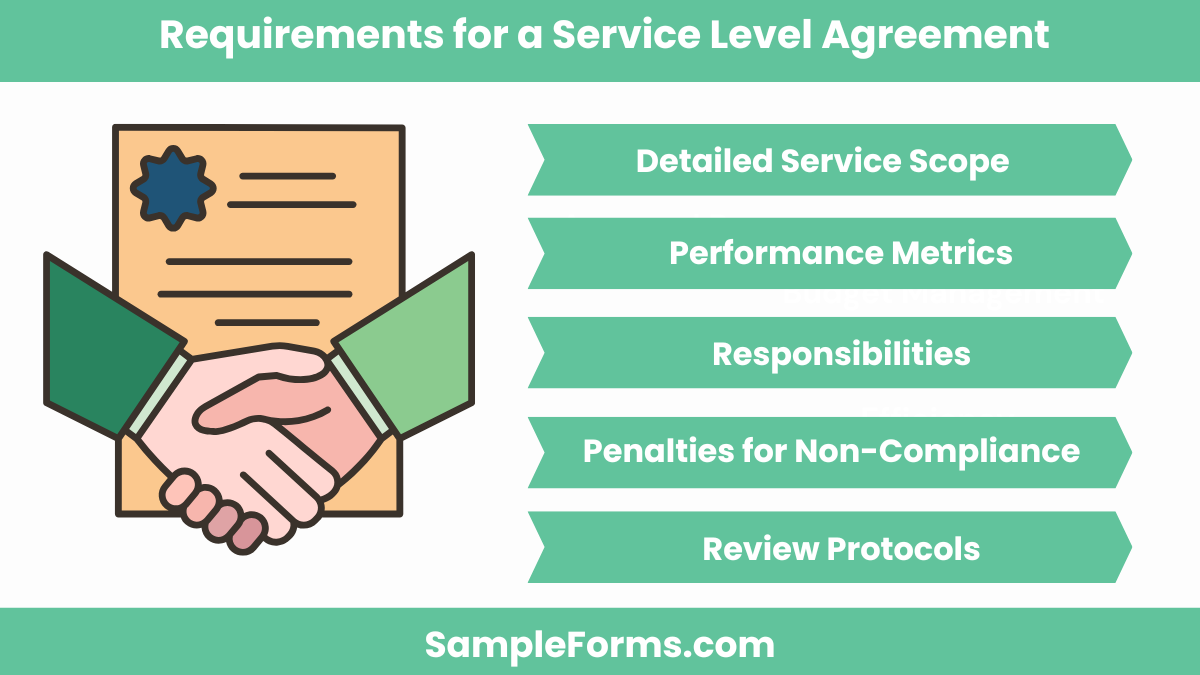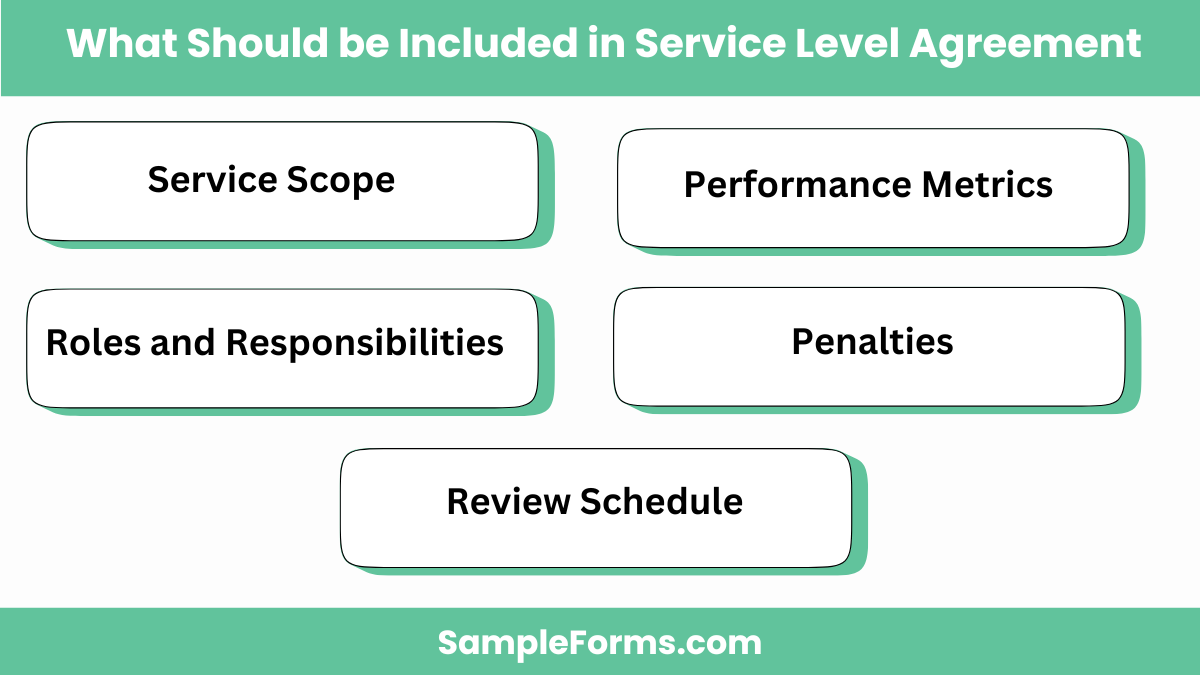A Service Level Agreement Form is an essential document outlining the standards of service agreed upon between a provider and a client. This guide provides everything you need to know about creating a Service Form and Agreement Form to ensure clarity in service commitments, expectations, and accountability. With examples and clear instructions, you’ll learn to craft a form that fosters transparency and strengthens client relationships. This guide also covers ways to use SLAs effectively across industries, making it easier to maintain high service standards and resolve disputes quickly.
Download Service Level Agreement Form Bundle
What is Service Level Agreement Form?
A Service Level Agreement Form is a contract that specifies the expectations, responsibilities, and quality metrics for services provided to a client. It helps define acceptable service levels, outlines response times, and includes penalties for not meeting standards. By using an SLA, both parties have a mutual understanding of performance criteria, minimizing misunderstandings and ensuring accountability. This form is especially useful in business-to-business (B2B) settings, where it clarifies roles and sets the foundation for a strong, transparent service relationship.
Service Level Agreement Format
Agreement Between:
Service Provider Name:
Client Name:
Effective Date:
Agreement Duration:
Objective of Agreement:
Define service expectations, performance standards, and responsibilities for [describe the service, e.g., “IT support services”].
Scope of Services:
1. Service Descriptions:
- Service details:
- Frequency of service:
- Special provisions:
2. Performance Standards:
- Response time:
- Resolution time:
- Availability (e.g., 24/7 support):
Roles and Responsibilities:
1. Service Provider:
- Outline provider’s main responsibilities, such as timely service, support provision, and quality assurance.
2. Client:
- List client’s responsibilities, such as access provision and necessary information for effective service.
Reporting and Monitoring:
- Describe metrics for performance review:
- Schedule for reporting:
- Tools/Platforms used for monitoring:
Terms of Payment:
1. Fees and Charges:
- Payment schedule:
- Payment methods:
2. Penalty for Non-Compliance:
- Fees for unmet performance:
- Conditions for waiver:
Termination Conditions:
- Grounds for agreement termination:
- Notification period:
Signatures:
- Service Provider Signature:
- Client Signature:
- Date of Signature:
Maintenance Service Level Agreement Form
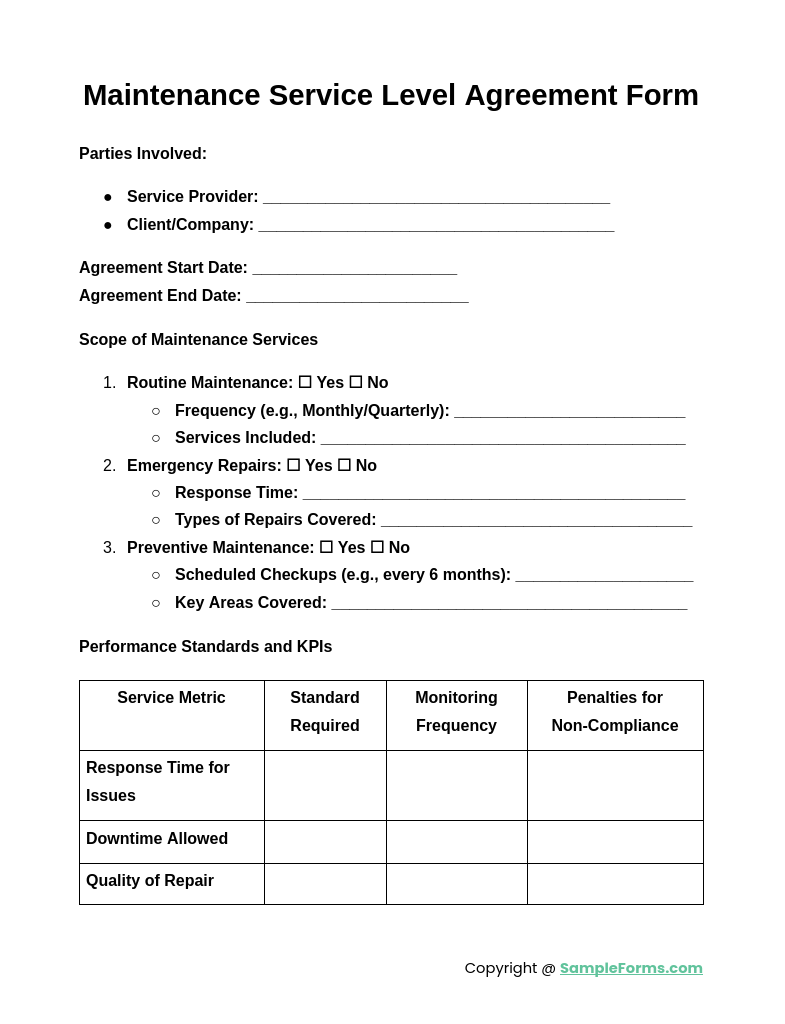
A Maintenance Service Level Agreement Form outlines standards and response times for maintenance services provided by a vendor. This form is crucial in setting clear expectations for service uptime, response to breakdowns, and routine checks. Commonly used in fields such as IT and equipment maintenance, it includes terms for preventive care, repair timelines, and emergency protocols. Similar to a Proof of Service Form, this document confirms that agreed maintenance obligations are met and validated.
Service Level Agreement Form PDF
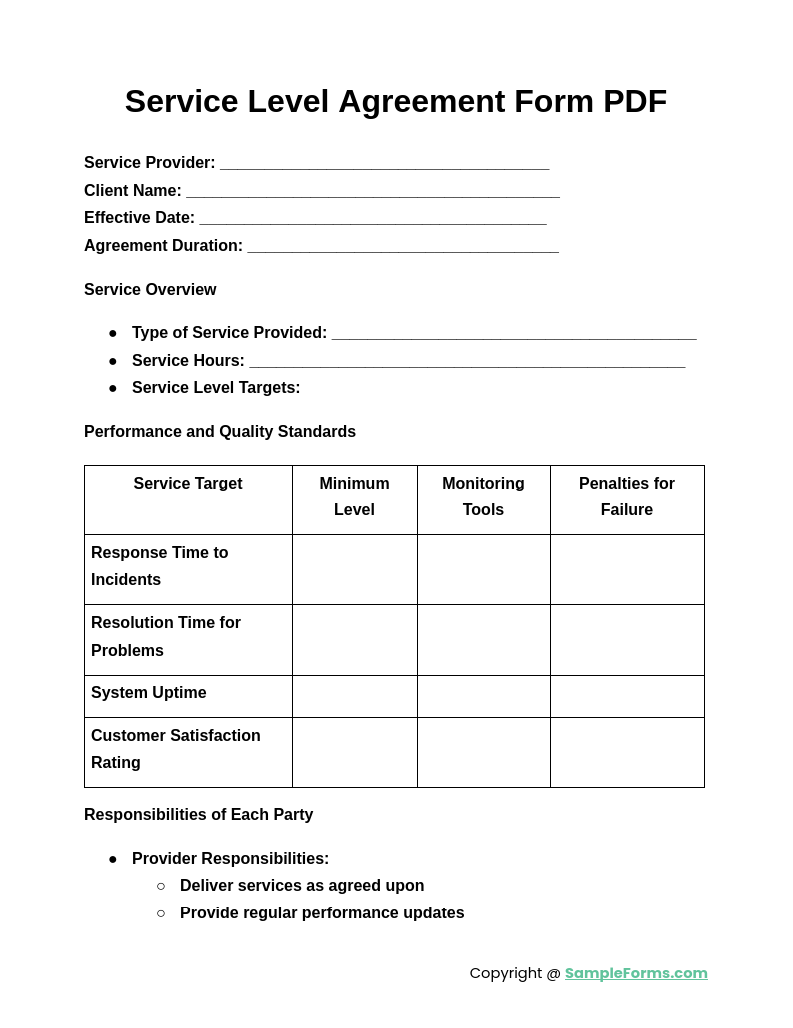
A Service Level Agreement Form PDF offers a convenient, standardized format for sharing and signing service agreements. This digital format enables easy distribution, secure storage, and quick reference. Users can download, fill out, and submit PDFs in compliance with agreed-upon terms. Often, it’s used in sectors requiring frequent contract renewals, as it offers clear, accessible terms. Comparable to a Social Service Form, a PDF SLA form allows for organized, paperless documentation of service commitments.
Service Level Agreement Form Template
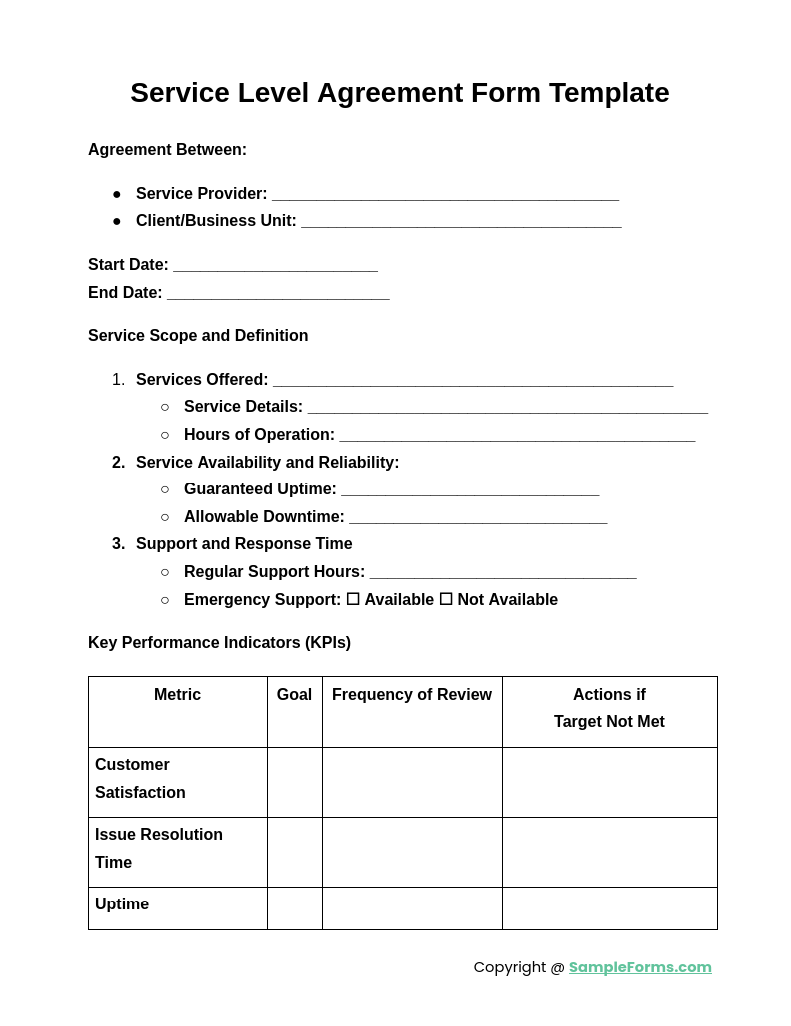
A Service Level Agreement Form Template provides a structured format that can be customized to fit specific service needs. This template includes key sections for defining scope, response times, quality metrics, and penalties for non-compliance, ensuring clarity in service terms. Using a template accelerates the SLA creation process, enabling consistent, professional documentation. Much like an Acknowledgment of Service Form, this template ensures both parties have a clear understanding of agreed terms before the start of services.
Internal Service Level Agreement Form
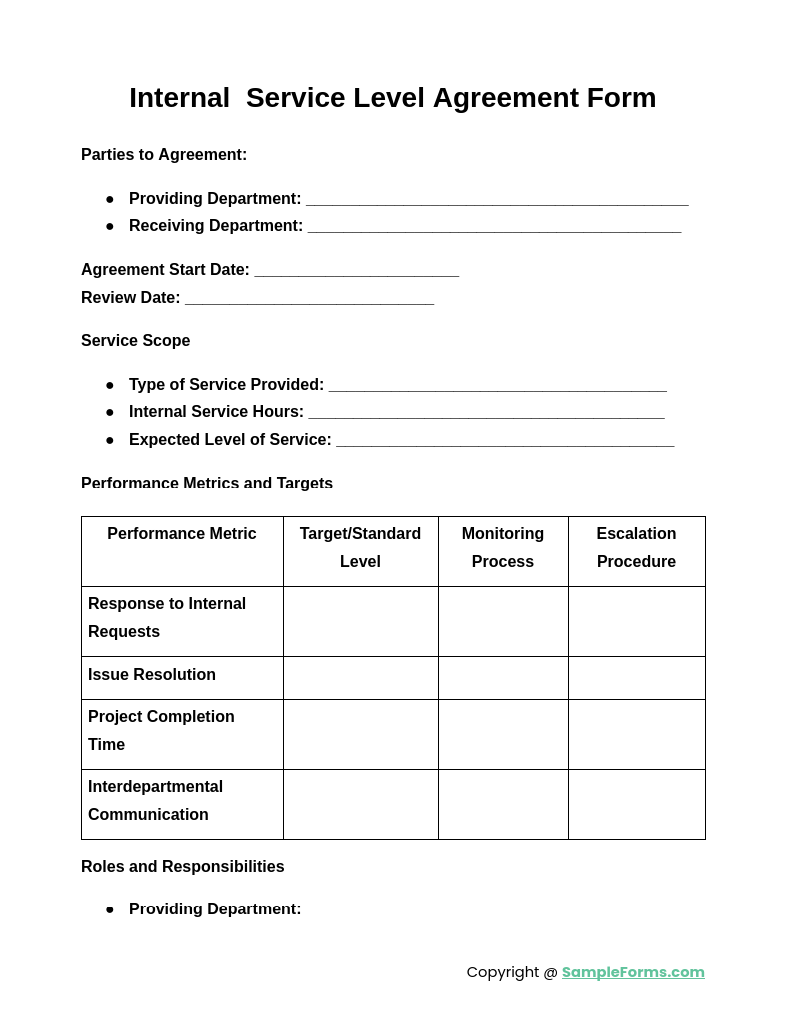
An Internal Service Level Agreement Form is used within organizations to set service expectations between departments, such as IT support for HR. It defines service standards, response times, and issue resolution metrics, helping streamline interdepartmental interactions and accountability. By using an internal SLA, companies can improve communication and performance across teams, ensuring efficient service and resource use. Similar to an Affidavit of Service Form confirming service completion, an internal SLA formalizes service expectations and performance metrics within a company.
Browse More Service Level Agreement Forms
Sample of Service Level Agreement
Service Level Agreement IT Support
Cloud Service Level Agreement
Internal Service Level Agreement
Service Level Agreement For Recruitment
Service Level Agreement Form
Customer Service Level Agreement
Data Center Service Level Agreement
Education Service Level Agreement
Finance Service Level Agreement
What are the requirements for a service level agreement?
A service level agreement requires clearly defined terms, metrics, penalties, and regular reviews to ensure alignment and effectiveness.
1. Detailed Service Scope: Specify services to be provided, like sections in a Lottery Syndicate Agreement Form for transparency.
2. Performance Metrics: Include measurable KPIs to track service quality.
3. Responsibilities: Outline roles of the service provider and client.
4. Penalties for Non-Compliance: Define consequences for not meeting the agreed standards.
5. Review Protocols: Schedule regular reviews to adjust the SLA based on evolving needs.
How do you write a simple service level agreement?
Writing a simple service level agreement involves defining service expectations, response times, and responsibilities clearly for both parties.
1. Define Services Offered: Outline all services provided, similar to listing specifics in a Buy Sell Agreement Form to avoid misunderstandings.
2. Set Performance Standards: Clearly state acceptable service levels and expected response times.
3. Establish Responsibilities: Assign duties to both parties to ensure mutual accountability.
4. Include Penalties: Define penalties for failing to meet performance standards.
5. Agree on Review Schedule: Set timelines to review and update the agreement as needed.
How to draw up a service level agreement?
To draw up an SLA, begin with service definitions, set performance metrics, assign responsibilities, and include penalties.
1. Define Service Objectives: Establish what the service aims to achieve, similar to setting goals in a Commercial Rental Agreement Form.
2. Set KPIs and Metrics: Determine how service quality and response times will be measured.
3. Outline Responsibilities: Assign clear roles to both provider and client.
4. Incorporate Penalties: Set consequences for failing to meet standards.
5. Sign and Document: Ensure both parties review, sign, and retain copies of the SLA.
What are the disadvantages of service level agreements?
While SLAs clarify expectations, they can lead to rigidity and potential conflicts if not managed well.
1. Inflexibility: SLAs can limit adaptability to changing needs.
2. Complexity: Detailed SLAs can be cumbersome, like lengthy clauses in a Settlement Agreement Form.
3. Potential for Conflict: Disputes may arise if service levels aren’t met.
4. Additional Costs: Failure to meet SLA standards can incur penalty costs.
5. Time-Consuming to Manage: Regular monitoring and updates are required to keep SLAs effective.
What should be included in every service level agreement?
Every SLA should include essential elements like service scope, performance standards, roles, and penalties for non-compliance.
1. Service Scope: Clearly define services provided, similar to outlining terms in a Rental Lease Agreement Form.
2. Performance Metrics: Include measurable KPIs for accountability.
3. Roles and Responsibilities: Assign duties to both service provider and client.
4. Penalties: Define consequences for unmet standards.
5. Review Schedule: Establish timelines for periodic SLA reviews.
Is a SLA legally binding?
Yes, an SLA is legally binding once signed, holding both parties accountable to agreed terms, similar to an Investment Agreement Form securing mutual responsibilities.
Who prepares an SLA?
The service provider typically drafts the SLA, tailoring it to service specifics, much like an Investment Club Agreement Form that outlines expectations within a group setting.
What happens if SLA is broken?
Breaking an SLA can result in penalties, compensation, or renegotiation, as detailed in a Financial Agreement Form when obligations aren’t met.
What are rules for SLA?
SLA rules include defining services, performance metrics, responsibilities, and penalties, similar to terms outlined in a Joint Venture Agreement Form to ensure clarity.
What are the three types of SLA?
The three types of SLAs are: customer, internal, and vendor SLAs, each serving specific roles, much like different sections in a Deposit Agreement Form.
What is the purpose of a SLA?
An SLA’s purpose is to outline service expectations, metrics, and accountability, similar to a Land Purchase Agreement Form that ensures both parties understand the deal.
What is the first step for a SLA?
The first step is identifying service requirements and objectives, like determining key terms before signing a Lease Agreement Form.
What are the three options for SLA?
The three options for SLAs are customer-based, service-based, and multi-level agreements, comparable to the structure of an Employment Agreement Form with distinct sections.
Does a service-level agreement need to be signed?
Yes, signing is crucial for enforceability, as it formalizes commitments, similar to the signing requirement in a Sublease Agreement Form.
What is the key point of a service level agreement?
The key point of an SLA is to define service standards and responsibilities, ensuring clarity, much like a Loan Agreement Form that details repayment obligations.
In conclusion, the Service Level Agreement Form is crucial for formalizing service expectations and commitments. This guide has explored sample forms, usage, and practical insights for creating an effective SLA. By following these steps, providers can offer high-quality services while clients gain confidence in the reliability of their vendors. Whether used in IT, customer support, or other sectors, an SLA promotes accountability and helps maintain service standards. Using a Trademark License Agreement Form approach can ensure compliance and consistency, strengthening the client-provider relationship.
Related Posts
-
FREE 5+ Rent a Room Agreement Forms in PDF | MS Word
-
FREE 5+ Commercial Sublease Agreement Forms in PDF | MS Word
-
FREE 7+ Garage (Parking) Rental Agreement Forms in PDF | MS Word
-
FREE 50+ Mortgage Forms Download – How to Create Guide, Tips
-
FREE 4+ Real Estate Listing Information Forms in PDF | MS Word
-
FREE 7+ Office Lease Agreement Forms in PDF | MS Word
-
FREE 4+ Salon Booth Rental Agreement Forms in PDF | MS Word
-
FREE 5+ Roommate Rental Agreement Forms in PDF | MS Word
-
Electrical Subcontractor Agreement Form
-
FREE 10+Non-Disclosure Forms in PDF | MS Word
-
FREE 5+ Construction Subcontractor Agreement Forms in PDF | MS Word
-
FREE 5+ Real Estate Lease Guarantee Co-Signer Agreement Forms in PDF | MS Word
-
FREE 5+ Lease with an Option to Purchase Agreement Forms in PDF | MS Word
-
FREE 7+ Realtors Lease Agreement Forms in PDF
-
FREE 10+ Subordination Agreement Forms in PDF | MS Word
